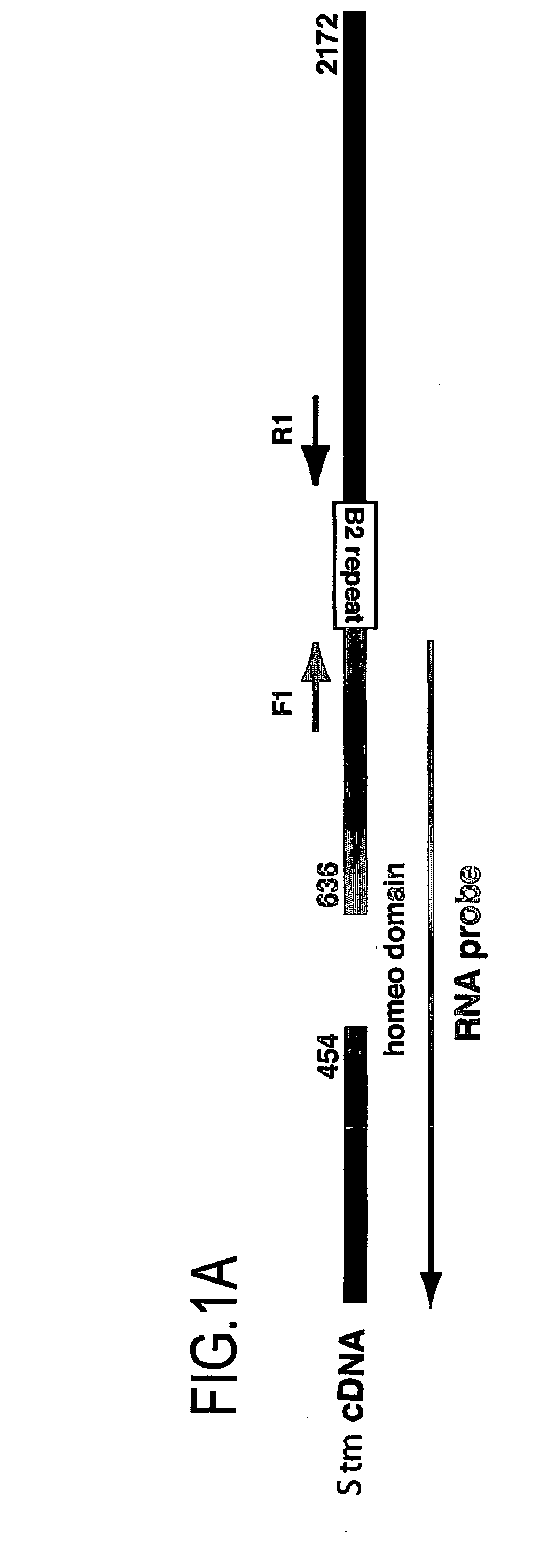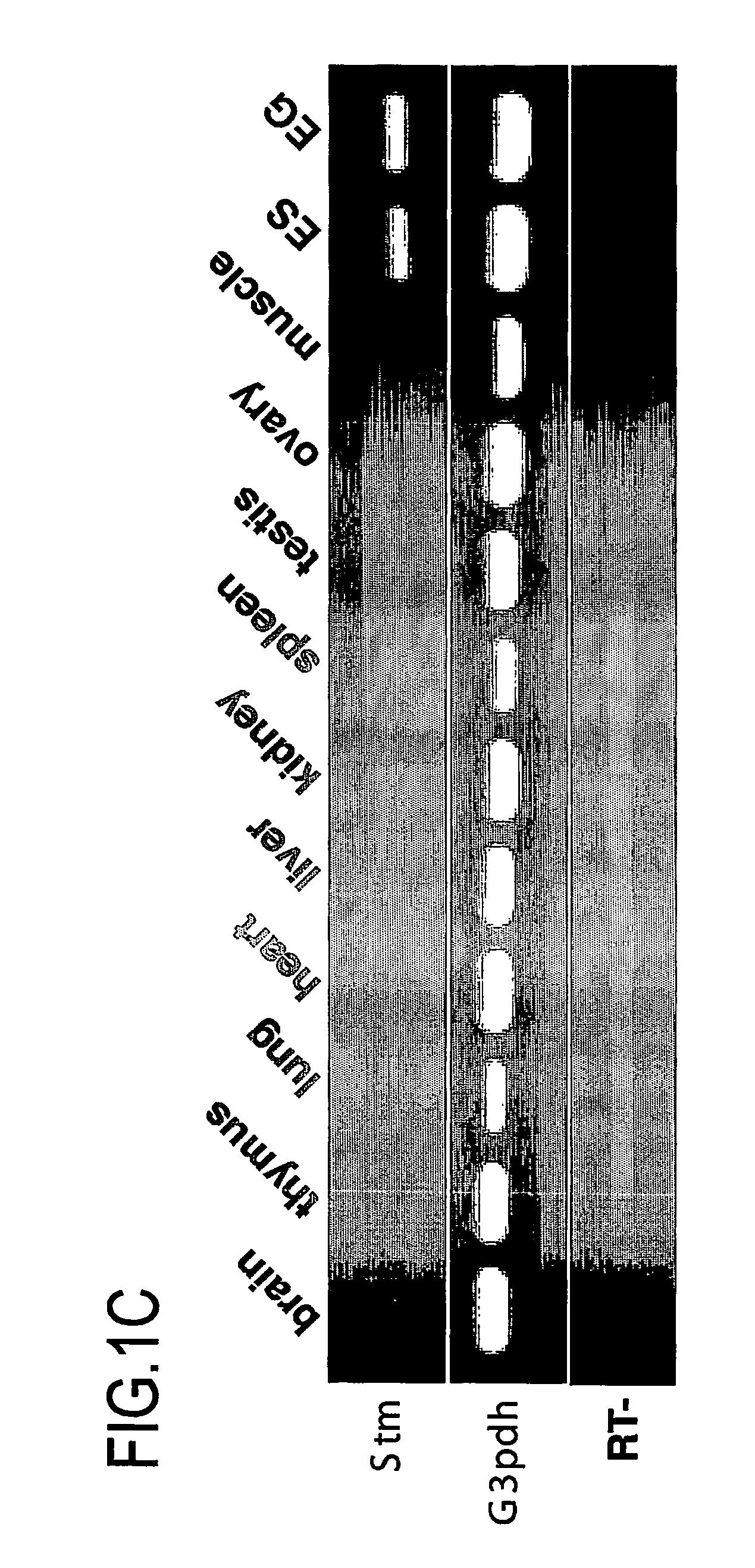Marker for undifferentiated state of cell and composition and method for separation and preparation of stem cells
a technology of undifferentiated state and cell, applied in the field of new markers, can solve the problems of inability to use as markers in the strict sense, inability to accurately determine oct3/4, limited use, etc., and achieve the effect of accurately determining and efficiently purifying stem cells
- Summary
- Abstract
- Description
- Claims
- Application Information
AI Technical Summary
Benefits of technology
Problems solved by technology
Method used
Image
Examples
example 1
[0516] In Example 1, a Stm gene was identified.
[0517] Total RNA was recovered from tissues using Trizol reagent (GIBCO-BRL) in accordance with manufacture's instructions. The tissues were the brain, thymus, lung, heart, liver, kidney, spleen, testis, ovary, and muscle of 8 week old adult mice, and E6.5, E7.5, E8.5, E9.5, E12.5, and E18.5-day-old mouse fetuses. In addition, RNA was recovered from the genital ridge, unfertilized eggs, morula, blastocyst, embryonic stem cells and EG cells derived from E12.5-day-old male and female mouse fetuses for experiments.
example 2
Northern Blot Hybridization Analysis
[0518] A general protocol (Alwine et. al., 1977, Proc. Natl. Acad. Sci., 74: 5350) was used to perform Northern blot hybridization analysis. Total RNA (10 μg), which had been extracted from embryonic stem cells, EG cells, and E12.5-day-old mouse fetuses, was dissolved in water, followed by electrophoresis using 1% formaldehyde degeneration gel. Thereafter, Hybond-N+ membrane (Amersham Biosciences) was used to perform blotting overnight. The blotted membrane was subjected to prehybridization at 42° C. for 2 hours and then hybridization using a specific probe overnight. Thereafter, the membrane was washed twice with 2×SSC / 0.1% SDS at 65° C., and once with 0.1×SSC / 0.1% SDS. The probe was labeled with [α-32P] dCTP (Amersham Biosciences) RI label using Megaprimer DNA labeling system (Amersham Biosciences) with respect to the full length of Stm1 cDNA.
example 3
Gene Expression Analysis by RT-PCR
[0519] For the purpose of expression analysis of Stm1, Oct3 / 4, and G3pdh genes by RT-PCR, an Oligo-dT primer was used to perform cDNA synthesis. RNA samples were treated with DNaseI. Thereafter, RT reaction was performed using Superscript II RT (GIBCO BRL) in accordance with manufacture's instructions. PCR amplification was performed using 1 μg of total RNA. A set of primers used are described below:
F1:(SEQ ID NO. 11)5′-GCGCATTTTAGCACCCCACA-3′andR1:(SEQ ID NO. 12)5′-GTTCTAAGTCCTAGGTTTGC-3′;F2:(SEQ ID NO. 13)5′-GAATTCTGGGAACGCCTCAT-3′andR2:(SEQ ID NO. 14)5′-CCAGATGTTGCGTAAGTCTC-3′;Oct3 / 4RT / 1:(SEQ ID NO. 15)5′-GGCGTTCTCTTTGGAAAGGTGTTC-3′andOct-4RT / 2:(SEQ ID NO. 16)5′-CTCGAACCACATCCTTCTCT-3′;G3PDH-5:(SEQ ID NO. 17)5′-TGAAGGTCGGTGTCAACGGATTTGGC-3′andG3PDH-3:(SEQ ID NO. 18)5′-CATGTAGGCCATGAGGTCCACCAC-3′.
[0520] PCR was performed under the following conditions: 5-min incubation at 94° C.; 30 cycles of 94° C. for 30 seconds, 60° C. for 30 seconds, and 72...
PUM
| Property | Measurement | Unit |
|---|---|---|
| temperature | aaaaa | aaaaa |
| pH | aaaaa | aaaaa |
| nucleic acid | aaaaa | aaaaa |
Abstract
Description
Claims
Application Information
 Login to View More
Login to View More - R&D
- Intellectual Property
- Life Sciences
- Materials
- Tech Scout
- Unparalleled Data Quality
- Higher Quality Content
- 60% Fewer Hallucinations
Browse by: Latest US Patents, China's latest patents, Technical Efficacy Thesaurus, Application Domain, Technology Topic, Popular Technical Reports.
© 2025 PatSnap. All rights reserved.Legal|Privacy policy|Modern Slavery Act Transparency Statement|Sitemap|About US| Contact US: help@patsnap.com



